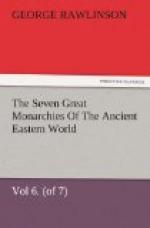Such are the chief remains of Parthian aesthetic art. They convey an idea of decline below the standard reached by the Persians of the Achaemenian times, which was itself a decline from the earlier art of the Assyrians. Had they been the efforts of a race devoid of models, they might fairly have been regarded as not altogether without promise. But, considered as the work of a nation which possessed the Achaemenian sculptures, and which had moreover, to a certain extent, access to Greek examples, a they must be pronounced clumsy, coarse, and wanting in all the higher qualities of Fine Art. It is no wonder that they are scanty and exceptional. The nation which could produce nothing better must have felt that its vocation was not towards the artistic, and that its powers had better be employed in other directions, e.g. in conquest and in organization. It would seem that the Parthians perceived this, and therefore devoted slight attention to the Fine Arts, preferring to occupy themselves mainly with those pursuits in which they excelled; viz. war, hunting, and government.
CHAPTER XXIII.
Customs of the Parthians—in Religion; in War; in their Embassies and Dealings with Foreign Nations; at the Court; in Private Life. Extent of the Refinement to which they reached. Their gradual Decline in Taste and Knowledge.
Very little is known as to the religion of the Parthians. It seems probable that during the Persian period they submitted to the Zoroastrian system, which was generally maintained by the Achaemenian kings, acquiescing, like the great bulk of the conquered nations, in the religious views of their conquerors; but as this was not their own religion, we may conclude that they were at no time very zealous followers of the Bactrian prophet, and that as age succeeded age they became continually more lukewarm in their feelings, and more lax in their religious practice. The essence of Zoroastrian belief was dualism—recognition of Ormazd as the great Principle of Good, and of Ahriman as the Principle of Evil. We need not doubt that, in word, the Parthians from first to last admitted this antagonism, and professed a belief in Ormazd as the supreme god, and a dread of Ahriman and his ministers. But practically, their religious aspirations rested, not on these dim abstractions, but on beings whose existence they could better realize, and whom they could feel to be less remote from themselves. The actual devotion of the Parthians was offered to the Sun and Moon, to deities who were supposed to preside over the royal house, and to ancestral idols which each family possessed, and conveyed with it from place to place with every change of habitation. The Sun was saluted at his rising, was worshipped in temples, under the name of Mithra, with sacrifices and offerings; had statues erected in his honor, and was usually associated with the lesser luminary.




